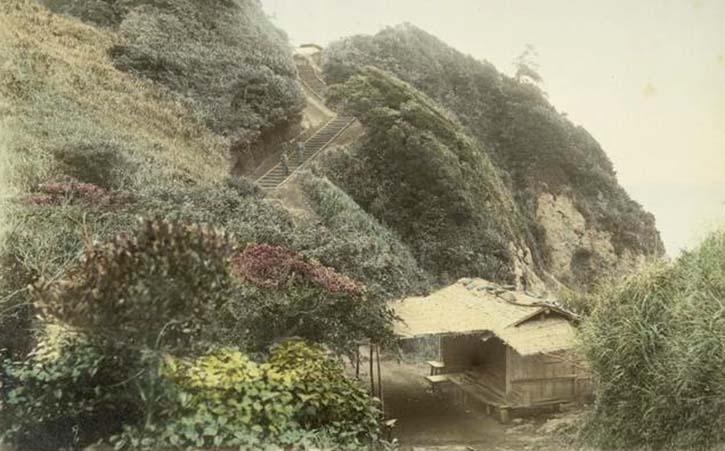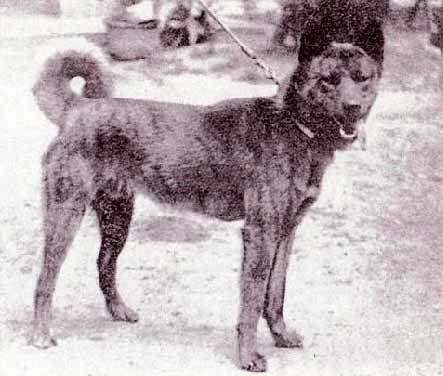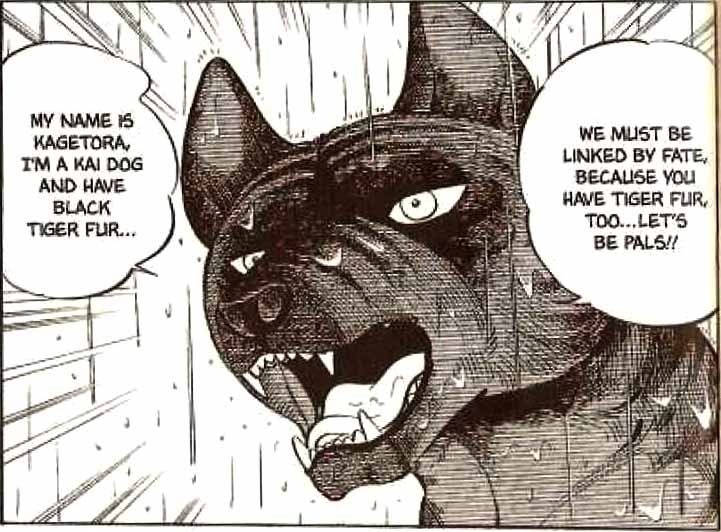The Kai Ken
breed
Kai Ken simply means a dog of Kai– an isolated, mountainous region of the Yamanashi prefecture in the south of Japan. Kai Ken are also referred to as Tora Inu (Tiger dogs) because of their striped coats. Sometimes they are called Kai Inu (Ken and Inu both mean dog in Japanese). Kai Ken are one of the six Japanese dog breeds, and they are an extremely rare breed, even in their native land.
Kai ken breed standards are published in slightly different forms by the Japan Kennel Club (JKF– site in Japanese) , Nihon ken Hozonkai (Nippo– site in Japanese), Kai Ken Aigokai (Kai Dog Protection Society - KKA) , and the United Kennel Club (UKC).
in the 19th century

History
The Kai district (today known as the Southern Alps) consists of high, rugged mountains. Perhaps due to the isolation of their homeland, Kai Ken are said to be the most primitive Japanese dog breed. Legend has it that the Kai were feral until about 200 years ago, when hunters discovered they were excellent working dogs who fit easily into domestic life.
In 1931 Dasuke Adachi, a prosecutor in Kofu, noticed a dog with an unusual brindled coat , and later traced this kind of dog to the Kai district. Adachi founded an organization dedicated to the preservation of this rare breed of dog, and brought two excellent dogs back to Kofu, where he established a breeding program. In 1933, thanks to the efforts of Haruo Isogai, the Kai Ken was declared by the government of Japan as a ‘Living Natural Monument’.
Few Japanese dogs survived the second world war, but the Kai Ken persevered in part due to its utility in police work and geographic isolation. Today the Kai is primarily a house dog, but hunters still work them to hunt pheasant, wild boar, and deer.
A few Kai were brought to the USA in the post war years, but practically speaking, Kai Kens began to show up in this country in the early 1990s.
Temperament
Kai are natural hunters and watch dogs– intelligent, alert, and fearless. They are naturally shy with strangers but affectionate and loyal to their families. They tend to bond strongly with one person. Kai are good with children and not usually aggressive, but the puppies can play rough and therefore need supervision when playing with smaller children.
Kai are more tractable that most Japanese dogs. They are natural hunters and have been known to swim or climb trees in pursuit of their prey. Given a chance they may run off in search of game, so never trust your Kai off lead unless in a fenced yard. They require moderate exercise. Naturally clean and odorless, they require infrequent bathing.
Kai are for experienced owners who can commit time and training to their dogs. The breed is naturally shy, so it’s important that Kai should ‘meet and greet a variety of people from puppyhood onward.
Kai are natural pack dogs and get along well with other dogs. They have a high prey drive, and will get along with other pets only if they are introduced when they are still puppies. Introducing a full grown Kai to a cat may prove a mistake, at least from the cat’s point of view.
Kai learn very quickly, and in Japan Kai have worked as police dogs with some currently active as search and rescue dogs. In Japan, they say ‘This dog will take a bullet for you.’ While easy to train, kai ken bond strongly to one master, and do not easily accept a new master following professional training. This is one reason Kai are not use more widely as working dogs. If you own a Kai, you should train him yourself.
Appearance
As is common with indigenous breeds, there is quite a bit of variation within the breed. Kai Ken are sturdy, medium sized dogs with strong limbs and hocks. Some Kai are cream colored, but most are shades of brindle: kuro-tora (black), chu-tora (medium), and aka-tora (red), with aka-tora being the rarest of the three variations.

ca 1930
Kai are double coated, shedding their undercoats in summer. They are muscular, have triangular heads, prick ears, and commonly have spots on their tongues. The tail may be curled over the back, or carried in a sickle position.
Males are larger and stronger the females, typically 18 to 22 inches at the shoulder– while the females are slightly smaller, 17 to 20 inches at the shoulder.
At one point, the Japanese specified two different kinds of kai. The shishi-inu-gata were thicker, stockier dogs with bear-like faces. The shika-inu-gata had thinner longer bodies with fox-like faces and were used to hunt deer. One type was not preferred over the other, and today the distinction is no longer made.

In popular culture
The 2010 children’s movie First Dog stars a Kai Ken named Little Bear, who at one point belonged to Nancy Reagan.

In Yoshihiro Takahashi’s manga series Ginga Legend Weed a Kai Ken named Kategora appears as a major character in chapter 14.